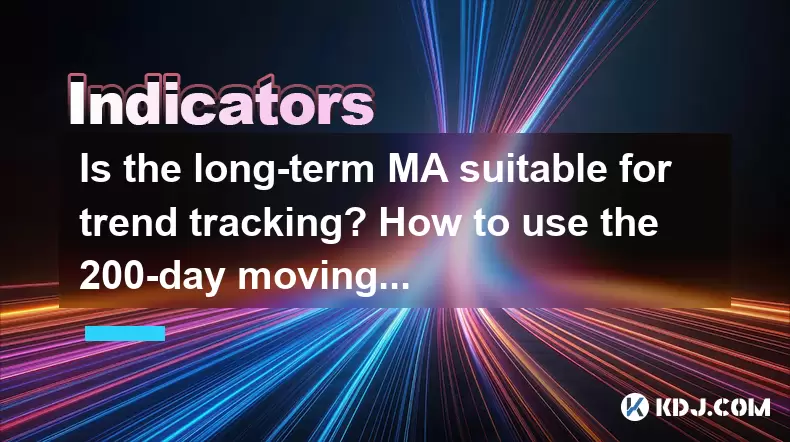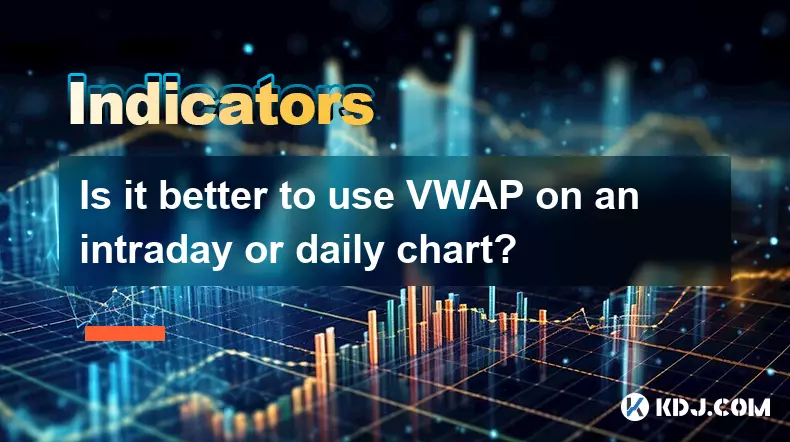-
 bitcoin
bitcoin $112715.707551 USD
-1.71% -
 ethereum
ethereum $4101.475385 USD
-3.01% -
 tether
tether $1.000644 USD
-0.02% -
 bnb
bnb $1207.619465 USD
-6.77% -
 xrp
xrp $2.501451 USD
-3.98% -
 solana
solana $202.947124 USD
-3.32% -
 usd-coin
usd-coin $1.000295 USD
0.04% -
 dogecoin
dogecoin $0.203884 USD
-4.47% -
 tron
tron $0.317154 USD
-1.72% -
 cardano
cardano $0.695009 USD
-4.43% -
 hyperliquid
hyperliquid $38.853961 USD
-8.23% -
 chainlink
chainlink $18.988674 USD
-4.64% -
 ethena-usde
ethena-usde $1.000233 USD
-0.03% -
 stellar
stellar $0.337050 USD
-3.63% -
 bitcoin-cash
bitcoin-cash $536.861728 USD
-1.28%
Is the long-term MA suitable for trend tracking? How to use the 200-day moving average?
The 200-day moving average is a key tool for tracking long-term trends in cryptocurrencies, signaling bullish or bearish markets based on price position relative to the MA.
May 21, 2025 at 11:29 pm

Introduction to Long-Term Moving Averages
Long-term moving averages (MAs) are widely used in the cryptocurrency market as tools for tracking trends and making informed trading decisions. Among these, the 200-day moving average is particularly popular due to its ability to provide a clear picture of long-term market trends. This article will delve into the suitability of long-term MAs for trend tracking and provide a detailed guide on how to use the 200-day moving average effectively in the context of cryptocurrencies.
Understanding Long-Term Moving Averages
Long-term moving averages are calculated by taking the average price of a cryptocurrency over a specified period, typically ranging from 50 to 200 days. These averages smooth out short-term fluctuations, allowing traders to focus on the underlying trend. The 200-day moving average is considered a benchmark for long-term trend analysis because it encompasses a significant portion of the market's history, making it less susceptible to short-term volatility.
Suitability of Long-Term MAs for Trend Tracking
Long-term MAs, especially the 200-day moving average, are highly suitable for trend tracking in the cryptocurrency market. They provide a reliable indicator of the market's direction over an extended period. When the price of a cryptocurrency is consistently above the 200-day MA, it indicates a bullish trend, suggesting that the market is in an upward trajectory. Conversely, if the price remains below the 200-day MA, it signals a bearish trend, indicating a downward movement.
How to Use the 200-Day Moving Average in Cryptocurrency Trading
To effectively use the 200-day moving average in cryptocurrency trading, follow these detailed steps:
Select a Reliable Charting Platform: Begin by choosing a charting platform that supports the addition of moving averages. Popular platforms include TradingView, Coinigy, and Binance's own charting tools.
Add the 200-Day MA to Your Chart: Once you have selected your platform, navigate to the settings or indicators section. Look for the option to add a moving average and set the period to 200 days. Ensure that the type of moving average is set to simple (SMA) or exponential (EMA), depending on your preference.
Analyze the Price Relative to the 200-Day MA: Observe the position of the cryptocurrency's price in relation to the 200-day MA. If the price is above the MA, it suggests a bullish trend. If the price is below the MA, it indicates a bearish trend.
Identify Crossovers: Pay close attention to moments when the price crosses the 200-day MA. A golden cross occurs when the price moves from below to above the 200-day MA, signaling a potential bullish reversal. Conversely, a death cross happens when the price moves from above to below the 200-day MA, indicating a potential bearish reversal.
Confirm with Additional Indicators: While the 200-day MA is a powerful tool, it is advisable to confirm your findings with other technical indicators such as the Relative Strength Index (RSI), Moving Average Convergence Divergence (MACD), or volume indicators to increase the accuracy of your analysis.
Set Trading Strategies Based on the 200-Day MA: Develop a trading strategy that aligns with the signals provided by the 200-day MA. For instance, you might decide to buy a cryptocurrency when the price moves above the 200-day MA and sell when it falls below it. Alternatively, you could use the MA as a guide for setting stop-loss orders to manage risk.
Practical Examples of Using the 200-Day Moving Average
To illustrate the application of the 200-day moving average, consider the following examples:
Bitcoin (BTC) Example: In early 2020, Bitcoin's price was hovering around the 200-day MA. As the price began to consistently trade above this level, it signaled the start of a bullish trend that continued throughout the year. Traders who recognized this signal and bought BTC at that time would have benefited from the subsequent price increase.
Ethereum (ETH) Example: In contrast, Ethereum experienced a death cross in mid-2018, where the price fell below the 200-day MA. This indicated a bearish trend, and the price continued to decline for several months. Traders who sold their ETH at the time of the death cross could have avoided further losses.
Limitations and Considerations When Using the 200-Day MA
While the 200-day moving average is a valuable tool, it is important to be aware of its limitations. The 200-day MA can be slow to react to sudden market changes, which may lead to delayed signals. Additionally, it is crucial to consider the broader market context and not rely solely on this indicator. Combining the 200-day MA with other forms of analysis, such as fundamental analysis or sentiment analysis, can provide a more comprehensive view of the market.
Frequently Asked Questions
Q: Can the 200-day moving average be used for short-term trading?A: The 200-day moving average is primarily designed for long-term trend analysis and may not be suitable for short-term trading. For short-term trading, shorter moving averages like the 50-day or 20-day MA might be more appropriate.
Q: How often should I check the 200-day moving average?A: Since the 200-day moving average is a long-term indicator, it does not require frequent monitoring. Checking it on a weekly or monthly basis should be sufficient for most traders.
Q: Is the 200-day moving average effective for all cryptocurrencies?A: While the 200-day moving average can be applied to any cryptocurrency, its effectiveness may vary depending on the liquidity and volatility of the specific coin. It tends to be more reliable for major cryptocurrencies like Bitcoin and Ethereum.
Q: Can the 200-day moving average be used in conjunction with other technical indicators?A: Yes, combining the 200-day moving average with other technical indicators such as RSI, MACD, or volume indicators can enhance the accuracy of your trading signals and provide a more robust analysis.
Disclaimer:info@kdj.com
The information provided is not trading advice. kdj.com does not assume any responsibility for any investments made based on the information provided in this article. Cryptocurrencies are highly volatile and it is highly recommended that you invest with caution after thorough research!
If you believe that the content used on this website infringes your copyright, please contact us immediately (info@kdj.com) and we will delete it promptly.
- PayPal, PYUSD, and Stablecoins: Riding the Wave of Digital Finance
- 2025-10-16 04:50:01
- Milk Mocha's $HUGS Token: Why the Whitelist & Presale 2025 are Exploding
- 2025-10-16 04:30:01
- Microsoft, Bitcoin, and GitHub: A Balancing Act in the Digital Age
- 2025-10-16 04:30:01
- Navigating the Crypto Chaos: Bitcoin Crash, Maturing Meme Coins, and Market Momentum
- 2025-10-16 04:30:01
- Sui Platform's Typus Finance Hit by Oracle Exploit: A Deep Dive
- 2025-10-16 05:10:01
- Solana's On-Chain Growth: Grayscale's Bets and the $260 Target
- 2025-10-16 04:40:01
Related knowledge

What's the main difference between VWAP and TWAP?
Oct 12,2025 at 11:54am
Understanding VWAP and Its Role in Crypto Trading1. Volume Weighted Average Price (VWAP) is a trading benchmark that calculates the average price of a...

How do you identify exhaustion moves using VWAP and its bands?
Oct 12,2025 at 08:00am
Understanding the Role of Decentralized Exchanges in Crypto Trading1. Decentralized exchanges (DEXs) operate without a central authority, allowing use...

Is it better to use VWAP on an intraday or daily chart?
Oct 15,2025 at 02:01am
Intraday Trading and the Role of VWAP1. Intraday traders frequently rely on VWAP (Volume Weighted Average Price) as a dynamic benchmark for assessing ...

How do you use VWAP to scale in and out of positions?
Oct 14,2025 at 02:19am
Understanding VWAP as a Dynamic Benchmark1. The Volume Weighted Average Price (VWAP) is not just an indicator—it functions as a dynamic benchmark that...

What are the main advantages of using VWAP over EMA?
Oct 11,2025 at 02:18am
Main Advantages of Using VWAP Over EMA1. Volume-Weighted Average Price (VWAP) incorporates trading volume into its calculation, offering a more accura...

How do you use VWAP on different chart types like Heikin Ashi?
Oct 11,2025 at 05:01pm
Understanding VWAP in the Context of Heikin Ashi Charts1. The Volume Weighted Average Price (VWAP) is a powerful analytical tool commonly used by trad...

What's the main difference between VWAP and TWAP?
Oct 12,2025 at 11:54am
Understanding VWAP and Its Role in Crypto Trading1. Volume Weighted Average Price (VWAP) is a trading benchmark that calculates the average price of a...

How do you identify exhaustion moves using VWAP and its bands?
Oct 12,2025 at 08:00am
Understanding the Role of Decentralized Exchanges in Crypto Trading1. Decentralized exchanges (DEXs) operate without a central authority, allowing use...

Is it better to use VWAP on an intraday or daily chart?
Oct 15,2025 at 02:01am
Intraday Trading and the Role of VWAP1. Intraday traders frequently rely on VWAP (Volume Weighted Average Price) as a dynamic benchmark for assessing ...

How do you use VWAP to scale in and out of positions?
Oct 14,2025 at 02:19am
Understanding VWAP as a Dynamic Benchmark1. The Volume Weighted Average Price (VWAP) is not just an indicator—it functions as a dynamic benchmark that...

What are the main advantages of using VWAP over EMA?
Oct 11,2025 at 02:18am
Main Advantages of Using VWAP Over EMA1. Volume-Weighted Average Price (VWAP) incorporates trading volume into its calculation, offering a more accura...

How do you use VWAP on different chart types like Heikin Ashi?
Oct 11,2025 at 05:01pm
Understanding VWAP in the Context of Heikin Ashi Charts1. The Volume Weighted Average Price (VWAP) is a powerful analytical tool commonly used by trad...
See all articles










































































